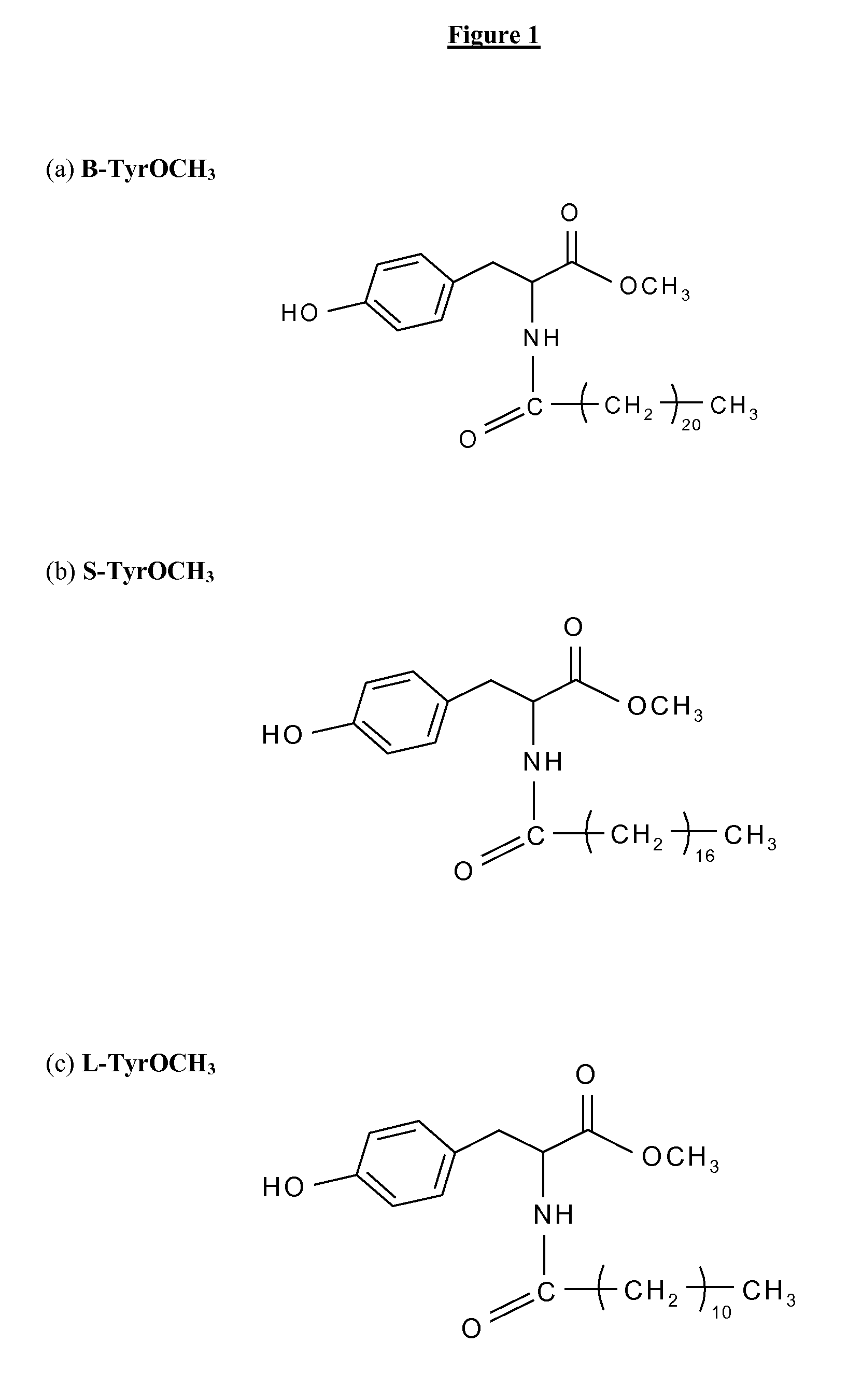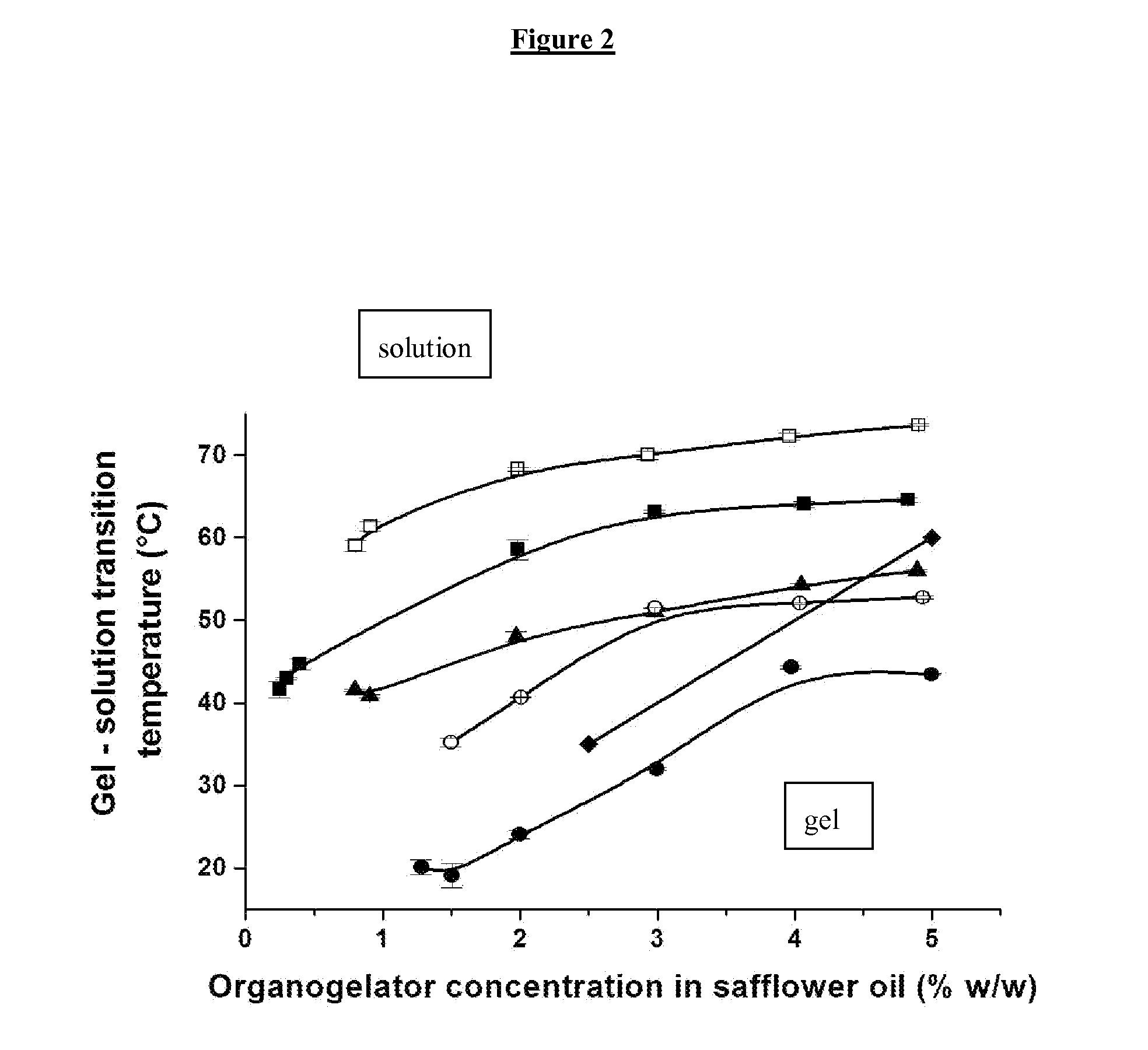Pharmaceutical composition with gelling properties containing a tyrosine derivative
a technology of tyrosine derivative and pharmaceutical composition, which is applied in the field of pharmaceutical compositions with gelling properties containing tyrosine derivatives, can solve the problems of few studies describing the use of organogels, limited patient care, and high cost of operation, and achieves the effects of reducing the risk of cancer, reducing the safety of use, and improving the safety of us
- Summary
- Abstract
- Description
- Claims
- Application Information
AI Technical Summary
Benefits of technology
Problems solved by technology
Method used
Image
Examples
example 1
Synthesis of Organogelators According to the Present Invention
[0070]N-Stearoyl L-Tyrosine methyl ester (S-TyrOCH3) is prepared by reaction of L-Tyrosine methyl ester hydrochloride (HCl-TyrOCH3) with N-Stearoyl chloride (S—COCl), as described thereafter.
[0071]HCl-TyrOCH3 (1.5 g, 1.1 eq) is suspended in 50 mL of chloroform in an ice bath. Triethylamine (1.80 mL, 2.2 eq) is added dropwise to the cold solution. The solution becomes limpid. After 15 min under stirring, S—COCl (1.78 g, 1 mol eq) is slowly added (dropwise) to the cold reaction mixture, in order to control the exothermic reaction. After 2 hours at 0° C., the mixture is heated at 45° C. overnight. The mixture remains clear.
[0072]The mixture is successively washed with water, a saturated aqueous solution of NaHCO3, brine, a solution of KHSO4 (1M), a solution of HCl (5-10%) and again water. The organic phase is dried (MgSO4), filtered, and concentrated under vacuum. The resulting colorless powder is purified by crystallization...
example 2
Characterization of the Organogelators Prepared at Example 1
1 / N-Stearoyl L-Tyrosine Methyl Ester (S-TyrOCH3).
[0074]Molecular formula: C28H47O4N.
[0075]Mass spectroscopy: Theoretical molecular weight: 461.68 g.mol−1.[0076]Experimental molecular weight: 461.2 g.mol−1
[0077]1H-NMR (400 MHz, CDCl3) δ (ppm): 0.88 (t, 3H), 1.25 (m, 28H), 1.6 (m, 2H), 2.17 (t, 2H), 3.05 (d-quad, 2H), 3.74 (s, 3H), 4.88 (quad, 1H), 5.89 (d, 1H) et 6.7-7.0 (m, 4H).
[0078]Elemental analysis: Theoretical: C, 72.84%, H, 10.26%, N, 3.03%.[0079]Experimental: C, 72.86%, H, 11.25%, N, 3.06%.
[0080]Yield: 77%.
[0081]Melting point: 103.7° C.
2 / N-Behenoyl L-Tyrosine Methyl Ester (B-TyrOCH3).
[0082]Molecular formula: C32H55O4N.
[0083]Mass spectroscopy: Theoretical molecular weight: 517.78 g.mol−1.
[0084]1H-NMR (400 MHz, CDCl3) δ (ppm): 0.88 (t, 3H), 1.25 (m, 36H), 1.57 (quint, 2H), 2.17 (t, 2H), 3.05 (d-quad, 2H), 3.73 (s, 3H), 4.87 (quad, 1H), 5.85 (d, 1H), 6.7-7.0 (m, 4H).
[0085]Elemental analysis: Theoretical: C, 74.23%, H, ...
example 3
Formation of Tyrosine-Based Organogel
[0096]Safflower oil is used as hydrophobic organic solvent in accordance with the invention. The organogelling substance chosen is N-stearoyl L-tyrosine methyl ester (S-TyrOCH3).
[0097]The following table summarizes the used proportions.
ProductFunctionProportionS-TyrOCH3Organogelator5% w / wSafflower oilHydrophobic organic solventQs ad 5 mL
[0098]Organogelator and safflower oil in adequate proportion were mixed and heated at a temperature higher than TGS, until dissolution of the organogelator. The solution was cooled at room temperature and the gel was obtained.
PUM
| Property | Measurement | Unit |
|---|---|---|
| transition temperature | aaaaa | aaaaa |
| transition temperature | aaaaa | aaaaa |
| period of time | aaaaa | aaaaa |
Abstract
Description
Claims
Application Information
 Login to View More
Login to View More - R&D
- Intellectual Property
- Life Sciences
- Materials
- Tech Scout
- Unparalleled Data Quality
- Higher Quality Content
- 60% Fewer Hallucinations
Browse by: Latest US Patents, China's latest patents, Technical Efficacy Thesaurus, Application Domain, Technology Topic, Popular Technical Reports.
© 2025 PatSnap. All rights reserved.Legal|Privacy policy|Modern Slavery Act Transparency Statement|Sitemap|About US| Contact US: help@patsnap.com



